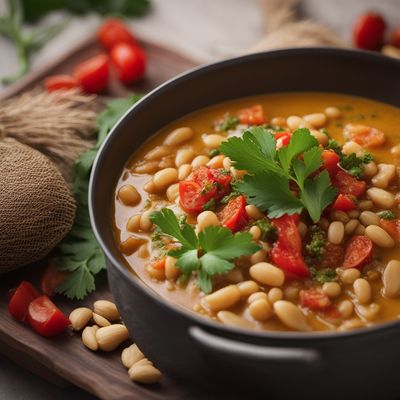
Recipe
Betawi-style Karē
Betawi Spiced Curry: A Fusion of Japanese and Indonesian Flavors
4.7 out of 5
Indulge in the rich and aromatic flavors of Betawi-style Karē, a delightful fusion of Japanese curry and Indonesian spices. This dish combines the comforting warmth of Japanese curry with the bold and vibrant spices of Betawi cuisine, resulting in a unique and tantalizing culinary experience.
Metadata
Preparation time
20 minutes
Cooking time
1 hour
Total time
1 hour 20 minutes
Yields
4 servings
Preparation difficulty
Medium
Suitable for
Omnivore, Gluten-free, Dairy-free, Nut-free, Low carb
Allergens
N/A
Not suitable for
Vegan, Vegetarian, Paleo, Keto, Halal
Ingredients
Betawi-style Karē differs from its Japanese counterpart by incorporating Betawi spices and flavors. While Japanese curry is known for its mild and sweet taste, Betawi-style Karē adds a touch of heat and complexity with the use of spices like lemongrass, galangal, and kaffir lime leaves. The addition of coconut milk also gives the curry a creamy and rich texture, enhancing the overall flavor profile. We alse have the original recipe for Karē, so you can check it out.
-
500g (1.1 lb) beef or chicken, cut into bite-sized pieces 500g (1.1 lb) beef or chicken, cut into bite-sized pieces
-
2 tablespoons vegetable oil 2 tablespoons vegetable oil
-
1 onion, finely chopped 1 onion, finely chopped
-
3 cloves garlic, minced 3 cloves garlic, minced
-
2 red chilies, sliced (optional for extra heat) 2 red chilies, sliced (optional for extra heat)
-
2 stalks lemongrass, bruised 2 stalks lemongrass, bruised
-
2 cm (0.8 inch) galangal, sliced 2 cm (0.8 inch) galangal, sliced
-
4 kaffir lime leaves 4 kaffir lime leaves
-
2 tablespoons curry powder 2 tablespoons curry powder
-
1 teaspoon turmeric powder 1 teaspoon turmeric powder
-
1 teaspoon coriander powder 1 teaspoon coriander powder
-
1 teaspoon cumin powder 1 teaspoon cumin powder
-
400ml (13.5 fl oz) coconut milk 400ml (13.5 fl oz) coconut milk
-
500ml (2 cups) chicken or beef broth 500ml (2 cups) chicken or beef broth
-
2 potatoes, peeled and cubed 2 potatoes, peeled and cubed
-
2 carrots, peeled and sliced 2 carrots, peeled and sliced
-
Salt, to taste Salt, to taste
-
Steamed rice or crusty bread, for serving Steamed rice or crusty bread, for serving
Nutrition
- Calories (kcal / KJ): 450 kcal / 1884 KJ
- Fat (total, saturated): 30g, 20g
- Carbohydrates (total, sugars): 15g, 5g
- Protein: 35g
- Fiber: 3g
- Salt: 1.5g
Preparation
-
1.Heat the vegetable oil in a large pot over medium heat. Add the chopped onion, minced garlic, and sliced red chilies (if using). Sauté until the onion becomes translucent.
-
2.Add the lemongrass, galangal, kaffir lime leaves, curry powder, turmeric powder, coriander powder, and cumin powder to the pot. Stir well to combine and cook for 2-3 minutes to release the flavors.
-
3.Add the beef or chicken pieces to the pot and cook until browned on all sides.
-
4.Pour in the coconut milk and chicken or beef broth. Stir to combine and bring the mixture to a simmer.
-
5.Reduce the heat to low and cover the pot. Let the curry simmer for 30 minutes, or until the meat is tender.
-
6.Add the cubed potatoes and sliced carrots to the pot. Continue simmering for an additional 15-20 minutes, or until the vegetables are cooked through.
-
7.Season with salt to taste.
-
8.Serve the Betawi-style Karē hot with steamed rice or crusty bread.
Treat your ingredients with care...
- Lemongrass — Bruise the lemongrass stalks by lightly pounding them with the back of a knife. This helps release the aromatic oils and enhances the flavor of the curry.
- Galangal — If fresh galangal is not available, you can substitute it with dried galangal powder. Use 1 teaspoon of powder for every 2 cm (0.8 inch) of fresh galangal.
- Kaffir lime leaves — To release the flavor, tear the kaffir lime leaves slightly before adding them to the curry.
Tips & Tricks
- For a milder curry, remove the seeds from the red chilies before slicing.
- Adjust the spiciness by adding more or fewer red chilies according to your preference.
- If you prefer a thicker curry, mix 1 tablespoon of cornstarch with a little water and add it to the curry during the last few minutes of cooking.
- Feel free to customize the vegetables in the curry according to your taste. Green beans, bell peppers, or peas make great additions.
- Leftover curry can be stored in the refrigerator for up to 3 days and tastes even better the next day as the flavors meld together.
Serving advice
Serve the Betawi-style Karē in individual bowls, accompanied by steamed rice or crusty bread. Garnish with fresh cilantro leaves or fried shallots for added flavor and visual appeal.
Presentation advice
To enhance the presentation, place a small bowl of sambal (Indonesian chili paste) on the side. This allows diners to adjust the spiciness of their curry according to their preference.
More recipes...
For Japanese cuisine » Browse all
For Betawi cuisine » Browse all
More Japanese cuisine dishes » Browse all

Robatayaki
Robatayaki is a Japanese cooking technique where food is grilled over an open flame. It is a popular method for cooking meat, seafood, and vegetables.

Karē pan
Karē pan is a popular Japanese snack that is made with a breaded and deep-fried shell filled with curry.

Bocchan dango
Bocchan dango is a traditional Japanese sweet that is made with mochi rice flour and sweet bean paste. It is a simple and flavorful dish that is...









